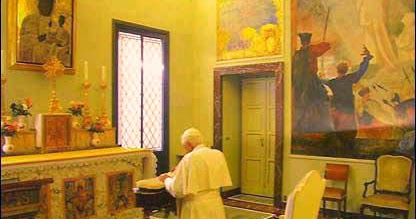wrongturn
Elder Lister
the "lockdown " has made me wonder through the interweb, stumbled upon this article. catholics , throught the world pray to these saints but still the whites consider blacks as inferior, they celebrate them .We even had black popes, i wonder when the rain started beating the black man. read more here https://www.catholicnewsherald.com/...s/344-black-catholic-popes-saints-and-leaders
Three popes of the early Church were born in north Africa:
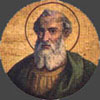 — Pope St. Victor I (189-198 or 199): He was the first pope to celebrate the liturgy and write Church documents in Latin rather than Greek. He is most famous for decreeing that Easter be universally celebrated on a Sunday, a practice already common in the West, but not so in the East. His feast day is July 28.
— Pope St. Victor I (189-198 or 199): He was the first pope to celebrate the liturgy and write Church documents in Latin rather than Greek. He is most famous for decreeing that Easter be universally celebrated on a Sunday, a practice already common in the West, but not so in the East. His feast day is July 28.
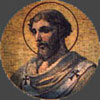 — Pope St. Miltiades (also called St. Melchiades) (311-314): He was pope when Constantine the Great defeated his enemies and assumed control over Rome, paving the way to the end of persecution of Christians. Constantine gave the pope the Lateran palace (now known as the Papal Archbasilica of St. John Lateran), which became the papal residence and seat of Christian governance. He was the last pope to be buried in a catacomb. His feast day is Dec. 10.
— Pope St. Miltiades (also called St. Melchiades) (311-314): He was pope when Constantine the Great defeated his enemies and assumed control over Rome, paving the way to the end of persecution of Christians. Constantine gave the pope the Lateran palace (now known as the Papal Archbasilica of St. John Lateran), which became the papal residence and seat of Christian governance. He was the last pope to be buried in a catacomb. His feast day is Dec. 10.
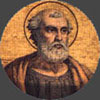 — Pope St. Gelasius I (492-496): The first pope to be called the Vicar of Christ, he is most famous for affirming the primacy of the papacy based on Jesus' command naming Peter the "rock of the Church." He promoted a type of "separation of Church and State" but emphasized that Church authority is always superior to civil law. He ordered reception of the Eucharist under both species, and he used his own funds and the papal lands to feed the poor of Rome during a severe famine. His feast day is Nov. 21.
— Pope St. Gelasius I (492-496): The first pope to be called the Vicar of Christ, he is most famous for affirming the primacy of the papacy based on Jesus' command naming Peter the "rock of the Church." He promoted a type of "separation of Church and State" but emphasized that Church authority is always superior to civil law. He ordered reception of the Eucharist under both species, and he used his own funds and the papal lands to feed the poor of Rome during a severe famine. His feast day is Nov. 21.
ST. MOSES THE BLACK
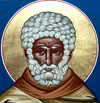 St. Moses the Black was a thief, murderer and adulterer who through the grace of conversion was transformed into a pacifist, priest and martyr.
St. Moses the Black was a thief, murderer and adulterer who through the grace of conversion was transformed into a pacifist, priest and martyr.
Born in 330, he was a slave of a government official in Egypt who dismissed him for theft and suspected murder. A large, imposing figure, he became the leader of a gang of bandits who roamed the Nile Valley spreading terror and violence. Attempting to hide from authorities, he took shelter with some monks in the desert near Alexandria. The dedication of their lives, as well as their peace and contentment, deeply influenced him. He gave up his sinful ways and joined the community. While he struggled a long time with monastic discipline, he became renowned for his mercy and zealous love of God and neighbor.
At some point, he was ordained a priest and became the leader of a colony of desert hermits. At about age 75, about the year 407, word came that a group of renegades planned to attack the colony. The brothers wanted to defend themselves, but Moses forbade it. He told them to retreat, rather than take up weapons. He and seven others remained behind and greeted the invaders with open arms. All eight were martyred by the bandits.
His feast day is Aug. 28.
ST. PACHOMIUS
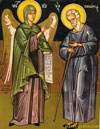 St. Pachomius can justifiably be called the founder of cenobitic monasticism (monks who live in community). Even though St. Anthony of Egypt was the first to go into the desert to pursue Christian perfection, he lived a primarily solitary life.
St. Pachomius can justifiably be called the founder of cenobitic monasticism (monks who live in community). Even though St. Anthony of Egypt was the first to go into the desert to pursue Christian perfection, he lived a primarily solitary life.
Pachomius first started out as a desert hermit, like many other men and women in the third and fourth centuries who sought the most radical expression of Christian life. There he developed a strong bond of friendship with the hermit Palemon. One day during prayer, he had a vision calling him to build a monastery. He was told in the vision that many people who were eager to live an ascetic life in the desert, but were not inclined to the solitary life of a hermit, would come and join him. Palemon helped him to build the monastery along the Nile River. Pachomius insisted that his cenobites were to aspire to the austerity of the hermits, but he knew that his idea was a radical one, because most of the men who came to live in his monastery had only ever conceived of the solitary lifestyle. His great accomplishment was to reconcile this desire for austere perfection with an openness to taking care of the mundane, day-to-day needs of community life as an expression of Christian love and service.
To aid the brothers in adjusting to a monastic life in community, he drew up a "rule" that was said to have been dictated to him by an angel. It is this rule that both St. Benedict in the west and St. Basil in the east drew upon to develop their better known rules of monastic community life. When he died in 346, there were 11 Pachomian monasteries: nine for men and two for women.
His feast day is May 9.
ST. MAURICE
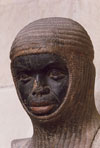 St. Maurice was a member of the Theban Legion, a Roman legion said to have been constituted by Christian soldiers from Africa, which was called to put down a revolt in Aaunum, located in modern-day Switzerland, in 287.
St. Maurice was a member of the Theban Legion, a Roman legion said to have been constituted by Christian soldiers from Africa, which was called to put down a revolt in Aaunum, located in modern-day Switzerland, in 287.
Two legends exist about the martyrdom of St. Maurice and his companions. According to the legends, the legion's soldiers were either ordered to take part in pagan sacrifices, or ordered to harass and kill some local Christians. In either event, the 6,600 men of Maurice's legion refused. In punishment for their disobedience, every 10th man in the legion was killed. When the remaining soldiers, fortified by St. Maurice, still refused, other legions were called in to force them to follow their orders. Persisting in their refusal, they were all massacred.
His feast day is Sept. 22.
ST. MARY OF EGYPT
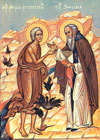 April 1 is the feast of a little-known saint whose story demonstrates the power of the Church as the home of forgiveness, redemption and mercy. St. Mary of Egypt was a prostitute for 17 years before she received the Eucharist and chose the life of a hermit.
April 1 is the feast of a little-known saint whose story demonstrates the power of the Church as the home of forgiveness, redemption and mercy. St. Mary of Egypt was a prostitute for 17 years before she received the Eucharist and chose the life of a hermit.
Born in 344, she moved to Alexandria when she was 12 to work as a prostitute. With the intention of plying her trade, she joined a large group making a pilgrimage to Jerusalem for the Feast of the Exaltation of the Holy Cross. On the feast day itself, she joined the crowd as it was headed to the church to venerate the relic of the True Cross, again with the intention of luring others into sin. When she got to the door of the church, she was unable to enter. A miraculous force propelled her away from the door each time she approached. After trying to get in three or four times, she moved to a corner of the churchyard and began to cry in remorse.
Then she saw a statue of the Blessed Virgin Mary. She prayed to Mary for permission to enter the church for the purposes of venerating the relic, and she promised her that if she were allowed to enter the church, she would renounce her sinful ways.
She entered the church, venerated the relic and returned to the statue outside to pray for guidance. She heard a voice telling her to cross the Jordan River and find rest. She set out and that evening she arrived at the Jordan and received Communion in a church dedicated to St. John the Baptist.
The next day, she crossed the river and went into the desert, where she lived alone for the next 47 years. Then, while making his Lenten retreat, a priest named Zosimus found the hermitess. She asked him to return to the banks of the Jordan on Holy Thursday of the following year and to bring her Communion. The priest was true to his word and returned bearing the Eucharist. Mary told him to come back again the next year, but to the place where he had originally met her.
When Zosimus returned in a year's time, he found Mary's corpse. On the ground beside it was a written request that she be buried accompanied by a statement that she had died one year ago, in 421, on the very night she had received Communion.
ST. CYRIL OF ALEXANDRIA
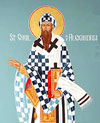 St. Cyril of Alexandria, Doctor of the Church, is best known for his role in the Council of Ephesus, where the Church confirmed that Christ is both God and man in one Person.
St. Cyril of Alexandria, Doctor of the Church, is best known for his role in the Council of Ephesus, where the Church confirmed that Christ is both God and man in one Person.
He was born in Alexandria between 370 and 380, the nephew of the patriarch of that city, Theophilus. He received a classical and theological education and was ordained by his uncle. He succeeded his uncle as patriarch of Alexandria in 412, but only after a riot between his supporters and the followers of a rival.
In 430 he became embroiled with Nestorius, patriarch of Constantinople, who was preaching that Mary was not the Mother of God but only the mother of Christ the man – thereby denying Christ's dual nature as both human and divine. He persuaded Pope Celestine I to convoke an ecunemical council at Rome from June 22 to July 31, 431. It was a tumultuous affair, with rival prelates from Constantinople and Alexandria and their advocates sometimes getting physically violent. But Cyril brilliantly defended the orthodox belief in Christ as a single eternally divine Person who also became incarnate as a man. The council condemned Nestorius, who was deposed as patriarch and later exiled.
During the rest of his life, Cyril wrote treatises on the Trinity and the Incarnation which helped prevent Nestorianism and other heresies from taking deep root in the Church. He was a brilliant theologian, and among his writings are commentaries on John, Luke and the Pentateuch, treatises on dogmatic theology, and letters and sermons. He died in 444 after serving as bishop for nearly 32 years. He was declared a Doctor of the Church by Pope Leo XIII in 1882.
His feast day is June 27.
ST. MONICA
Raised a Christian, St. Monica was married off to a much older and violent-tempered official in North Africa who was a pagan. His mother lived with them and was equally difficult, which proved a constant challenge to St. Monica. She had three children: Augustine, Navigius and Perpetua. Through her patience and prayers, she was able to convert her husband and mother-in-law to the Catholic faith in 370. Her husband died a year later. Perpetua and Navigius entered religious life.
St. Augustine was much more difficult, as she had to pray for him for 17 years, begging the prayers of priests who, for a while, tried to avoid her because of her persistence at this seemingly hopeless endeavor. One priest did console her by saying, "it is not possible that the son of so many tears should perish." This thought, coupled with a vision that she had received, strengthened her. St. Augustine was baptized by St. Ambrose in 387. St. Monica died later that same year, on the way back to Africa from Rome. Her feast day is Aug. 27.
Three popes of the early Church were born in north Africa:



ST. MOSES THE BLACK

Born in 330, he was a slave of a government official in Egypt who dismissed him for theft and suspected murder. A large, imposing figure, he became the leader of a gang of bandits who roamed the Nile Valley spreading terror and violence. Attempting to hide from authorities, he took shelter with some monks in the desert near Alexandria. The dedication of their lives, as well as their peace and contentment, deeply influenced him. He gave up his sinful ways and joined the community. While he struggled a long time with monastic discipline, he became renowned for his mercy and zealous love of God and neighbor.
At some point, he was ordained a priest and became the leader of a colony of desert hermits. At about age 75, about the year 407, word came that a group of renegades planned to attack the colony. The brothers wanted to defend themselves, but Moses forbade it. He told them to retreat, rather than take up weapons. He and seven others remained behind and greeted the invaders with open arms. All eight were martyred by the bandits.
His feast day is Aug. 28.
ST. PACHOMIUS

Pachomius first started out as a desert hermit, like many other men and women in the third and fourth centuries who sought the most radical expression of Christian life. There he developed a strong bond of friendship with the hermit Palemon. One day during prayer, he had a vision calling him to build a monastery. He was told in the vision that many people who were eager to live an ascetic life in the desert, but were not inclined to the solitary life of a hermit, would come and join him. Palemon helped him to build the monastery along the Nile River. Pachomius insisted that his cenobites were to aspire to the austerity of the hermits, but he knew that his idea was a radical one, because most of the men who came to live in his monastery had only ever conceived of the solitary lifestyle. His great accomplishment was to reconcile this desire for austere perfection with an openness to taking care of the mundane, day-to-day needs of community life as an expression of Christian love and service.
To aid the brothers in adjusting to a monastic life in community, he drew up a "rule" that was said to have been dictated to him by an angel. It is this rule that both St. Benedict in the west and St. Basil in the east drew upon to develop their better known rules of monastic community life. When he died in 346, there were 11 Pachomian monasteries: nine for men and two for women.
His feast day is May 9.
ST. MAURICE

Two legends exist about the martyrdom of St. Maurice and his companions. According to the legends, the legion's soldiers were either ordered to take part in pagan sacrifices, or ordered to harass and kill some local Christians. In either event, the 6,600 men of Maurice's legion refused. In punishment for their disobedience, every 10th man in the legion was killed. When the remaining soldiers, fortified by St. Maurice, still refused, other legions were called in to force them to follow their orders. Persisting in their refusal, they were all massacred.
His feast day is Sept. 22.
ST. MARY OF EGYPT

Born in 344, she moved to Alexandria when she was 12 to work as a prostitute. With the intention of plying her trade, she joined a large group making a pilgrimage to Jerusalem for the Feast of the Exaltation of the Holy Cross. On the feast day itself, she joined the crowd as it was headed to the church to venerate the relic of the True Cross, again with the intention of luring others into sin. When she got to the door of the church, she was unable to enter. A miraculous force propelled her away from the door each time she approached. After trying to get in three or four times, she moved to a corner of the churchyard and began to cry in remorse.
Then she saw a statue of the Blessed Virgin Mary. She prayed to Mary for permission to enter the church for the purposes of venerating the relic, and she promised her that if she were allowed to enter the church, she would renounce her sinful ways.
She entered the church, venerated the relic and returned to the statue outside to pray for guidance. She heard a voice telling her to cross the Jordan River and find rest. She set out and that evening she arrived at the Jordan and received Communion in a church dedicated to St. John the Baptist.
The next day, she crossed the river and went into the desert, where she lived alone for the next 47 years. Then, while making his Lenten retreat, a priest named Zosimus found the hermitess. She asked him to return to the banks of the Jordan on Holy Thursday of the following year and to bring her Communion. The priest was true to his word and returned bearing the Eucharist. Mary told him to come back again the next year, but to the place where he had originally met her.
When Zosimus returned in a year's time, he found Mary's corpse. On the ground beside it was a written request that she be buried accompanied by a statement that she had died one year ago, in 421, on the very night she had received Communion.
ST. CYRIL OF ALEXANDRIA

He was born in Alexandria between 370 and 380, the nephew of the patriarch of that city, Theophilus. He received a classical and theological education and was ordained by his uncle. He succeeded his uncle as patriarch of Alexandria in 412, but only after a riot between his supporters and the followers of a rival.
In 430 he became embroiled with Nestorius, patriarch of Constantinople, who was preaching that Mary was not the Mother of God but only the mother of Christ the man – thereby denying Christ's dual nature as both human and divine. He persuaded Pope Celestine I to convoke an ecunemical council at Rome from June 22 to July 31, 431. It was a tumultuous affair, with rival prelates from Constantinople and Alexandria and their advocates sometimes getting physically violent. But Cyril brilliantly defended the orthodox belief in Christ as a single eternally divine Person who also became incarnate as a man. The council condemned Nestorius, who was deposed as patriarch and later exiled.
During the rest of his life, Cyril wrote treatises on the Trinity and the Incarnation which helped prevent Nestorianism and other heresies from taking deep root in the Church. He was a brilliant theologian, and among his writings are commentaries on John, Luke and the Pentateuch, treatises on dogmatic theology, and letters and sermons. He died in 444 after serving as bishop for nearly 32 years. He was declared a Doctor of the Church by Pope Leo XIII in 1882.
His feast day is June 27.
ST. MONICA
Raised a Christian, St. Monica was married off to a much older and violent-tempered official in North Africa who was a pagan. His mother lived with them and was equally difficult, which proved a constant challenge to St. Monica. She had three children: Augustine, Navigius and Perpetua. Through her patience and prayers, she was able to convert her husband and mother-in-law to the Catholic faith in 370. Her husband died a year later. Perpetua and Navigius entered religious life.
St. Augustine was much more difficult, as she had to pray for him for 17 years, begging the prayers of priests who, for a while, tried to avoid her because of her persistence at this seemingly hopeless endeavor. One priest did console her by saying, "it is not possible that the son of so many tears should perish." This thought, coupled with a vision that she had received, strengthened her. St. Augustine was baptized by St. Ambrose in 387. St. Monica died later that same year, on the way back to Africa from Rome. Her feast day is Aug. 27.

